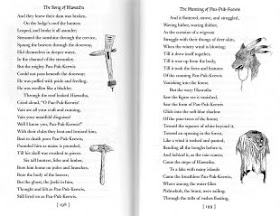Frederic Remington illustrated the 1891 edition of The Song of Hiawatha (1855). That’s the one I have been using, reprinted by David R. Godine in 2004. Remington’s illustrations of the story itself, one per canto, are pedestrian. More unusual, better, are the drawings on the right margin of every page: tools, clothing, animals, faces, picture writing, sometimes relevant to the text, but as often not.
The objects are from Remington’s own collection, or from museums, and as a result are primarily modern Plains Indian artifacts. I think they add immeasurably to the attractiveness of the book itself, but they also highlight a problem with Longfellow’s poem. Longfellow wanted to write an “Indian epic.” What is an Indian epic?
The first Canto is titled “The Peace Pipe.” The poem begins:
On the Mountains of the Prairie,
On the great Red Pipe-stone Quarry,
Gitche Manito, the mighty,
He the Master of Life, descending,
On the red crags of the quarry
Stood erect, and called the nations,
Called the tribes of men together.
The Red Pipe-stone Quarry is a specific place, now a National Monument in Minnesota, that I hope to visit some day. Longfellow, like Remington, is describing a specific, existing object. But the quarry is also generalized, made part of a broader story, an “Indian” story. “Came the Mandans and Dacotahs, \ Came the Hurons and Ojibways” and so on. Longfellow’s Indian epic is constructed out of bits and pieces of the legends of many peoples, Iroquois and Ojibwa, primarily, all filtered through the writings of early proto-anthropologists.
Is The Song of Hiawatha a diluted Ojibwa story, or a hodgepodge of many stories, or a genuine synthesis? The Red Pipe-stone Quarry really did have special significance for a widespread group of people, so it’s a great place to start. I’m not so sure that Longfellow succeeds as well everywhere else. The fact that his up-to-the-minute anthropological research has now been largely replaced just reminds me of the dangers of up-to-the-minuteness.
The poem ends with the appearance of a Jesuit priest, perhaps Père Marquette himself. The peaceful Hiawatha greets the priest, listens respectfully, and then, like King Arthur or Frodo, crosses the waters “To the Land of the Hereafter!” The Indian culture hero recognizes the approaching death of his world, and withdraws. As an ending to the poem Longfellow wrote, this is about perfect. As an idea with some relationship to actual Native American culture, I see a few problems. Have any later poets, Native American or otherwise, tried to reclaim Hiawatha from Longfellow? They must have. I can imagine several approaches, not all of which use the word “resistance.”
I have no problem with any writer appropriating, as they say, the culture, language, beliefs, or religion of anyone else, nor do I put much value on respect. I love a good travesty. Take your shot, Mr. Poet, and let’s see how you do. The Song of Hiawatha was, politically, progressive, to introduce another anachronism. Sincere. Longfellow took Native American culture seriously, as did Frederic Remington. And that genuine interest was artistically transformed into – into what? In 1855, American readers were prepared to feel nobly interested in Native American culture and deeply moved by its eclipse, now that the conflict had moved a thousand miles west. In 1891, what reader doubted that Hiawatha really was gone, and could never return? In 2010 – I’m still thinking about it.

Do you think Longfellow's poem fits right in with the "noble savage" image that was so prevalent during his day, and before as well as after.
ReplyDeleteIt sounds very much in league with Oronoka by Aphra Behn, Last of the Mohicans, and others.
I'd love to hear what Native American critics have to say as well.
This has been an interesting series of reviews. Thanks.
I am a very bad Minnesotan because I have never read the whole of the poem. I keep intending one of these days to sit on the banks of Minnehaha Creek above the falls near the statue of Hiawatha carrying Minnehaha and read the poem, but alas, I have not done so in spite of always being reminded about it. I live only a couple blocks from Lake Nokomis and Minnehaha Creek, a ten minute bike ride from the falls I mentioned, and regularly drive on a street called Hiawatha as well. Oh, the neighborhood surrounding the falls is called Longfellow and its boundary is shared with my neighborhood, Nokomis East. There are probably lots of other things in my area related to the poem that I have not noticed for my lack of having read the poem.
ReplyDeletestefanie - You have a much better reason to read Hiawatha than I do! It's short - shorter than Sartor Resartus! Ha ha ha!
ReplyDeleteCB - The complication is that Hiawatha fulfills a lot of consciously chosen mythological roles - he's a culture hero, for example, and a monster-slayer. So Longfellow is up to date on his anthropological treatment of mythology. I don't detect any Rousseau, but now that you mention it, I wonder. Cooper is openly mythological, too.
And Behn, of course, is 100 years before Rousseau, so I shouldn't need him to think about the, should I? I plead ignorance.